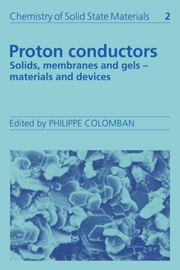Book contents
- Frontmatter
- Contents
- List of contributors
- Preface
- Symbols
- I HYDROGEN BOND AND PROTONIC SPECIES
- 1 The hydrogen bond and chemical parameters favouring proton mobility in solids
- 2 Protonic species and their structures
- 3 Proton conductors: classification and conductivity
- 4 Defects, non-stoichiometry and phase transitions
- 5 Structural studies of proton conductors
- 6 Hydrogen in metals: structure, diffusion and tunnelling
- II MATERIALS: PREPARATION, STRUCTURES AND PROPERTIES
- III PROTON DYNAMICS AND CHARGE TRANSPORT
- IV PROTON DIFFUSION MECHANISMS
- V DEVICES
- Index
5 - Structural studies of proton conductors
Published online by Cambridge University Press: 04 May 2010
- Frontmatter
- Contents
- List of contributors
- Preface
- Symbols
- I HYDROGEN BOND AND PROTONIC SPECIES
- 1 The hydrogen bond and chemical parameters favouring proton mobility in solids
- 2 Protonic species and their structures
- 3 Proton conductors: classification and conductivity
- 4 Defects, non-stoichiometry and phase transitions
- 5 Structural studies of proton conductors
- 6 Hydrogen in metals: structure, diffusion and tunnelling
- II MATERIALS: PREPARATION, STRUCTURES AND PROPERTIES
- III PROTON DYNAMICS AND CHARGE TRANSPORT
- IV PROTON DIFFUSION MECHANISMS
- V DEVICES
- Index
Summary
The structural situation
Let us here focus on the special structural situations we are likely to meet in studying crystalline proton conductors, and on how these can best be treated by conventional crystallographic refinement techniques. Reasonably, the same types of local situation occur in amorphous solids and in liquids, but their lack of translational symmetry renders them inaccessible to accurate study. We shall see that access to high quality single-crystal data (X-ray or neutron) gives no guarantee of a satisfactory result; careful thought must also be given to the method of refinement. Since many structural examples of proton conducting materials can be found elsewhere in this book, we shall here approach the problem from a general standpoint. Examples will subsequently be taken from the author's own work to illustrate the structural situations discussed.
What then is the structural feature most characteristic of a proton conductor system? It is generally believed that a proton is transferred through a solid in one of two distinct ways: by a vehicular mechanism, whereby the proton rides on a carrier molecule of type NH4+ or H3O+ ion, or by a Grotthuss mechanism, in which the proton jumps from a donor to a suitably placed acceptor molecule (typically, from H3O+ to H2O, or from H2O to OH–). How then is such a process sensed in a conventional diffraction experiment?
- Type
- Chapter
- Information
- Proton ConductorsSolids, Membranes and Gels - Materials and Devices, pp. 79 - 89Publisher: Cambridge University PressPrint publication year: 1992
- 2
- Cited by



